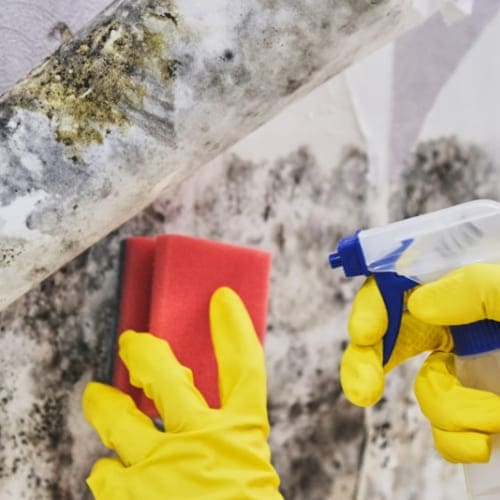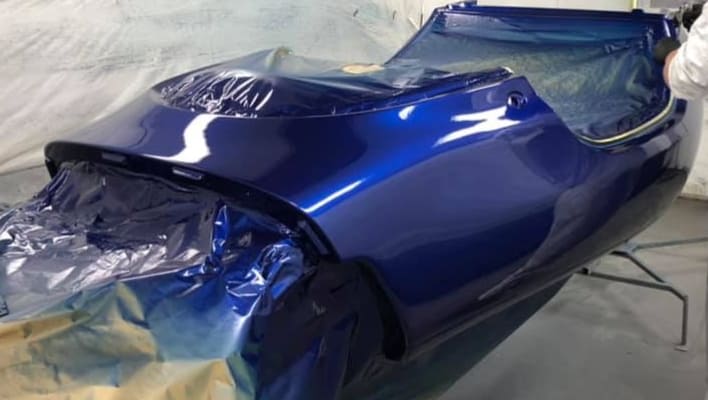Painting over mold is not a wise approach when dealing with a mold problem. Mold is not only unsightly but could also lead to health risks, making it essential to fix the issue properly. While a fresh coat of paint may seem like a quick fix, it is important to understand that painting over mold is merely a cosmetic solution that does not eliminate the underlying problem.
Though, there are some paints that claim to have mold-resistant properties and prevent the growth of mold on the painted walls. These paints may be suitable for areas with a history of mold problems or in environments prone to high humidity, such as bathrooms and walls.
Table of Contents
- Can You Paint Over Mold?
- What happens if you paint over mold?
- How To Remove Mold That Has Been Painted Over?
- Will paint kill mold?
- Best Paint To Cover Mold and Damp
- 1. Dap 10308 Interior Plaster White – best to cover mold
- 2. Gorilla Waterproof Patch & Seal Liquid – best paint to cover mold on ceiling
- Wrapping Up
- FAQs On paint over mold
- Q. How do you treat mold before painting?
- Q. What kills mold permanently?
- Q. Can mold be painted over?
- Q. Does kilz paint kill mold?
- Rosalie Sanchez
Can You Paint Over Mold?
Painting over mold is not recommended for several significant reasons. It may appear to be an easy fix, but it simply conceals the visible mold while not addressing the underlying problem. The spores of mold can continue to grow beneath the paint, which allows them to spread. Paint masks a potentially more extensive mold issue that requires proper remediation by covering it with paint.

Painting over mold with old paint can be dangerous, as it may not effectively address the mold issue and could pose health risks.
What happens if you paint over mold?
Health Hazards: Mold poses a significant health risk. Inhaling or touching certain molds can result in mycotoxins, which can be harmful. Mold can still release spores into the air even after being painted over.
Structural Deterioration: Mold can destroy drywall, wood, and insulation by weakening and damaging them. By painting over mold, you’re not addressing structural damage. This can lead to more extensive and costly repairs in the future.
Ineffectiveness: Paint is not an effective mold inhibitor or remediation method. Mold can persist and spread beneath the paint, causing peeling or cracking, or bubbles. This can make the issue more noticeable and difficult to resolve.
Mold remediation: Regulations and guidelines dictate that mold remediation must be performed by trained professionals in many countries. If mold is painted over, this may not comply with legal requirements, which could lead to fines or penalties.
Resale Implications: Painting over mold without remediation can cause difficulties during a home inspection. The hidden mold problem may reveal itself to prospective buyers, causing delays or negotiations that may negatively affect the sale price.
Aesthetic Concerns: If mold is successfully covered with paint, it may still show through or reappear over time, resulting in unsightly blemishes.
How To Remove Mold That Has Been Painted Over?

Getting rid of mold that has been painted over can be a challenging task, as the paint creates a barrier that seals the mold underneath. It’s better to take proper precautions and follow these steps to effectively amend the issue:
- Wear protective gear, including a mask, gloves, and safety goggles, to avoid inhaling mold spores or coming into direct contact with them.
- Check the surface to determine the extent of mold growth. Sometimes, mold may be more extensive behind walls or under surfaces.
- Scrape off the painted surface using a sandpaper or scraper. Dispose of the removed paint and mold-contaminated materials in sealed bags.
- Clean the affected area thoroughly with a commercial mold cleaner or a paste of water and detergent. Scrub the surface to eliminate all visible mold thoroughly and disinfect the affected area.
- Determine and rectify the source of moisture that allowed the mold to thrive. It could be a plumbing issue, leaky roof, or poor ventilation.
- Replace or repair any materials that cannot be salvaged, such as drywall, insulation, or wood, if they are severely damaged by mold.
- After ensuring the area is completely dry and mold-free, repaint with a high-quality mold-resistant paint to avoid future mold growth.
- Take preventive measures to avoid future mold issues, such as maintaining proper ventilation, controlling humidity levels, and fixing any leaks promptly.
Will paint kill mold?
When it comes to addressing mold issues in my bathroom and on wooden surfaces, I trust Rust-Oleum Zinsser mold killing primer. Its white, matte finish seamlessly blends with the surroundings.
What truly makes it invaluable is its exceptional odor-blocking capability, perfect for eliminating persistent mold-related odors and ensuring a fresh, clean environment.
This versatile Rust-Oleum best mold killing primer covers up to 100 square feet, and its rapid drying time, with touch-dry in just 25 minutes, allows for a swift project completion, especially in mold-prone areas. It adheres effortlessly to glossy surfaces, including bathroom tiles and wooden panels, without the need for extensive preparation.
Moreover, its low odor and compatibility with various topcoats make it my top choice for effectively tackling mold and revitalizing my bathroom and wooden spaces with ease.
Best Paint To Cover Mold and Damp
1. Dap 10308 Interior Plaster White – best to cover mold
I recently chose Dap 10308 Interior Plaster of Paris in White for my mold covering project, and it’s been a fantastic choice. The glossy finish it offers gives my molds a professional and polished look. Its smooth formula ensures consistent and impressive results each time I use it.
What I love most is its quick setting time of just 20-30 minutes, allowing me to complete repairs and projects in no time.
2. Gorilla Waterproof Patch & Seal Liquid – best paint to cover mold on ceiling
Gorilla Waterproof Seal Liquid is another paint to cover mold and mildew. This 32-ounce clear pack effectively seals out moisture, air, and water, preventing and controlling leaks. Its versatility allows for easy application with various methods.
It’s durable, with temperature and UV resistance, and could be painted over with oil-based or latex paints. Perfect for roofs, ceilings, gutters, PVC joints, and more, it’s a reliable choice for various sealing projects, but not for continuous submersion or underwater use.
Wrapping Up
While it may be tempting to cover up mold with paint, it’s far from being a wise approach. Mold demands thorough removal and remediation to save both your health and property.
Nevertheless, there are reputable paints and primers that can assist in preventing future mold issues when used alongside proper mold removal methods.
FAQs On paint over mold
Q. How do you treat mold before painting?
Before painting over mold, it’s advisable to fix it properly. Start by applying a small amount of household bleach that has not been diluted.
If the discoloration fades away, revealing the original paint surface, you’re likely dealing with mold or mildew. This simple test helps confirm the presence of mold before proceeding with painting.
Q. What kills mold permanently?
Vinegar and Hydrogen peroxide is a highly effective solution to permanently eliminate mold. It works well on various surfaces like walls, bathroom fixtures, floors, and kitchen appliances. You can also use bleach to remove mold on concrete.
Simply pour a 3% concentration of hydrogen peroxide into a spray bottle and thoroughly spray the mold-infested area, ensuring it’s fully saturated with the hydrogen peroxide solution. This method is a reliable way to get rid of mold for good.
Q. Can mold be painted over?
Painting over mold is not an effective solution, as paint does not eliminate mold and can actually worsen the issue. Mold will persist and resurface over time. If left unchecked, it can even spread to the drywall, compromising its integrity and safety.
Thus, removing and replacing the affected drywall becomes necessary to resolve the mold problem effectively.
Q. Does kilz paint kill mold?
Kilz paint is designed for use on surfaces prone to mold and mildew. However, it’s important to remember that the surface must be free from any remaining mold or mildew before priming and painting for the better results.
To prepare the surface effectively, clean it with a mildew remover, rinse with water, and allow it to dry before proceeding with the primer and paint application. This ensures a durable and mold-resistant finish.

Rosalie Sanchez
DIY enthusiast with years of experience in home decor and home improvement. With a passion for educating consumers about DIY projects. Every time, I work with our painting professionals to provide you with the best painting product reviews and how-to advice. You can follow me on Facebook.


